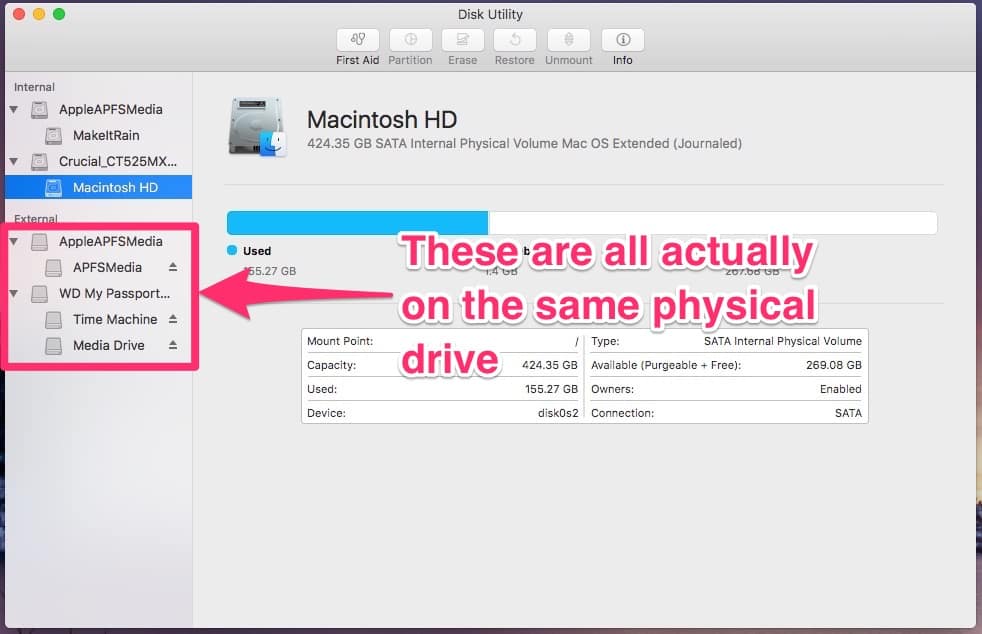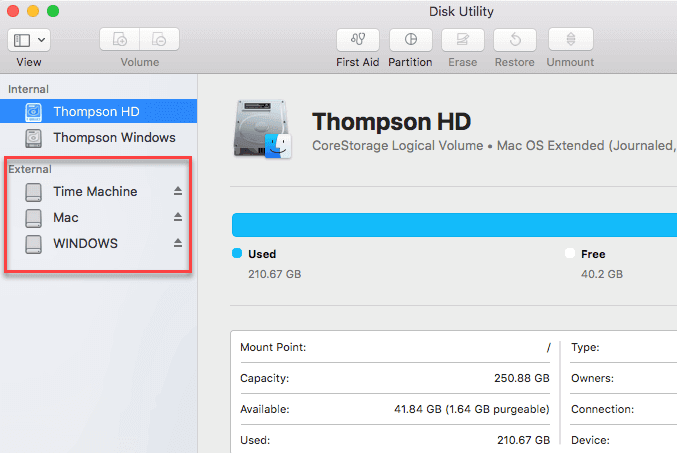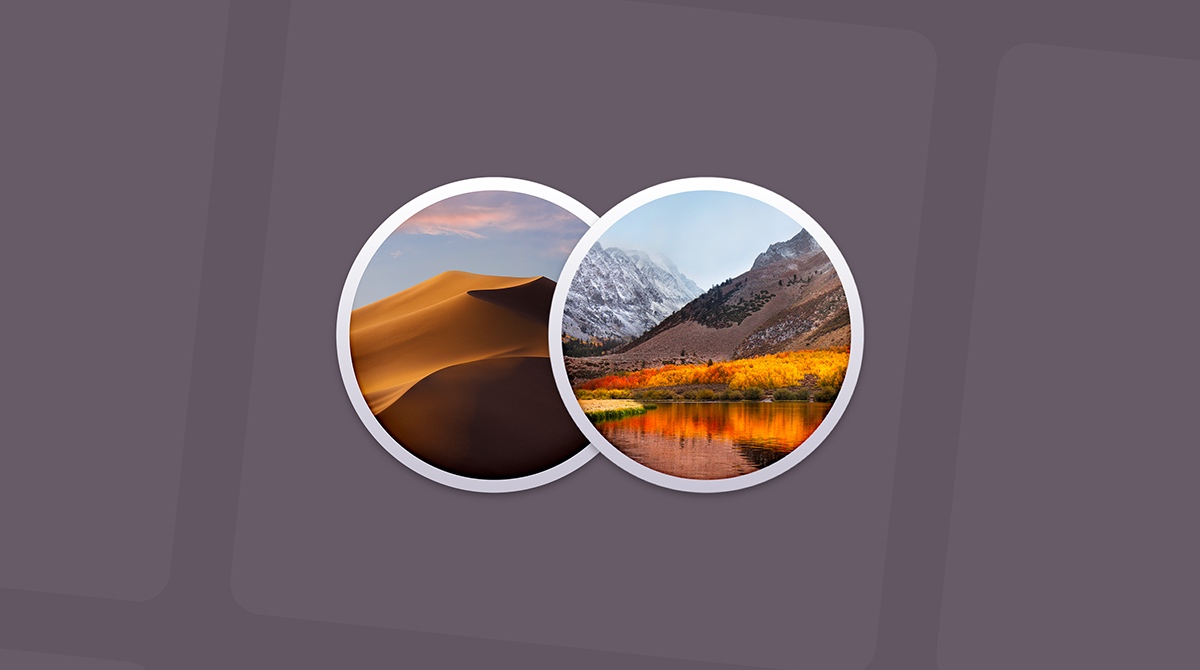

- #PARTITION A EXTERNAL HARD DRIVE FOR A DIFFERENT SCHEME IN OSX HIGH SIERRA HOW TO#
- #PARTITION A EXTERNAL HARD DRIVE FOR A DIFFERENT SCHEME IN OSX HIGH SIERRA FOR MAC#
- #PARTITION A EXTERNAL HARD DRIVE FOR A DIFFERENT SCHEME IN OSX HIGH SIERRA UPDATE#
- #PARTITION A EXTERNAL HARD DRIVE FOR A DIFFERENT SCHEME IN OSX HIGH SIERRA SERIES#
- #PARTITION A EXTERNAL HARD DRIVE FOR A DIFFERENT SCHEME IN OSX HIGH SIERRA MAC#
#PARTITION A EXTERNAL HARD DRIVE FOR A DIFFERENT SCHEME IN OSX HIGH SIERRA SERIES#
This article attempts to explain how this comes about, and how it works (differently) in APFS, and is part of a series which will eventually look at the boot process in its traditional form, in APFS, and Apple’s new Secure Boot.

In Terminal, though, and it tells me that my iMac has four disks (disk0 to disk3), with a grand total of 12 partitions, from disk0s0 to disk3s2. Disk Utility displays them as two ‘disks’, each with a single volume. It also doesn't require complicated ACLs and file attribution system like NTFS.If you’ve ever used a command tool which works with disks and volumes, you’ll be aware of the fact that what the Finder shows, and even what gets listed in /Volumes, is only a fraction of what macOS knows about.Īccording to the Finder, and /Volumes, at the moment this iMac has two storage systems accessible: its internal Fusion Drive, and an external RAID array which is used for Time Machine backups. exFAT has no realistic file or partition size limits. exFAT is the preferred file format for flash storage drives that you share between Windows and Mac. This was designed by Microsoft to provide similar compatibility to FAT32 without the pesky limitations.
#PARTITION A EXTERNAL HARD DRIVE FOR A DIFFERENT SCHEME IN OSX HIGH SIERRA MAC#
Manufacturers like Seagate lets you read and write data interchangeably on Windows and Mac without formatting the external drive. You can only access drives formatted with HFS+ on Windows through third-party apps. Even if you’re using SSD as a Time Machine drive, it’s not compatible with APFS.
#PARTITION A EXTERNAL HARD DRIVE FOR A DIFFERENT SCHEME IN OSX HIGH SIERRA UPDATE#
If you have older Macs (pre–2016), particularly those too old to update to a recent version of macOS, choosing HFS+ will enable you to use your external drive with those machines.įor Time Machine backups, use MacOS Extended (Journaled) if it’s a mechanical hard drive or if you’re using macOS Catalina or earlier. If you bought a Mac between those dates, it shipped with macOS (or OS X, as it was known) installed on an HFS+ volume.
#PARTITION A EXTERNAL HARD DRIVE FOR A DIFFERENT SCHEME IN OSX HIGH SIERRA FOR MAC#
Mac OS Extended, also known as HFS+ (Hierarchical File System Plus), was the main file system used for Mac system storage from 1998 until APFS launched in 2017. Here are some of the best apps that read-write APFS on Windows.

You can only access drives formatted with APFS on Windows through third-party apps. If you connect that disk to Catalina, Time Machine won’t recognize it. Time Machine volumes formatted as APFS will only work with Macs running Big Sur or later. It’s fast, consumes less space, which means more room for backups, has greater resistance to data corruption, and copies cloned or sparse files efficiently. Time Machine backups to APFS are impressive when compared to HFS+. However, you won’t be asked this option for the already formatted HFS+ disk. On macOS Big Sur, Apple lets you format an external drive and choose APFS for Time Machine. An external SSD gives you the best performance over APFS, provided you don’t need to use the drive with other pre-Sierra Macs. If speed and convenience are your top priorities and cost is not an issue. Note: You’ll lose all the data in the external drive, make sure to back it up.

Type in the disk name you want, then select your preferred option for both Format and Partition Scheme. Be sure to choose the device, not the volume or volumes it contains. In the sidebar, select the external storage device. Now choose View > Show All Devices to see the storage device at the top level, then the container, and finally any volumes that are in the container. In the left panel, you’ll see the listing of internal and external drives separately. For a Mac user, neither of these file systems is desirable. It’ll likely be already formatted, either for Windows (using NTFS) or for maximum compatibility (using FAT32). Once you’ve bought a new external storage drive, connect it to your Mac.
#PARTITION A EXTERNAL HARD DRIVE FOR A DIFFERENT SCHEME IN OSX HIGH SIERRA HOW TO#
How to Format Your Drive With Disk Utility Let’s look at the best file system formats to use for your Mac's external drive. With the Disk Utility app, you can easily format the drive, give it a label, or even partition it and create multiple volumes. Once you have it, your first task is to pick a suitable file system for that drive depending on your intended usage. The easiest way to add storage to your Mac is to buy an external hard drive.


 0 kommentar(er)
0 kommentar(er)
